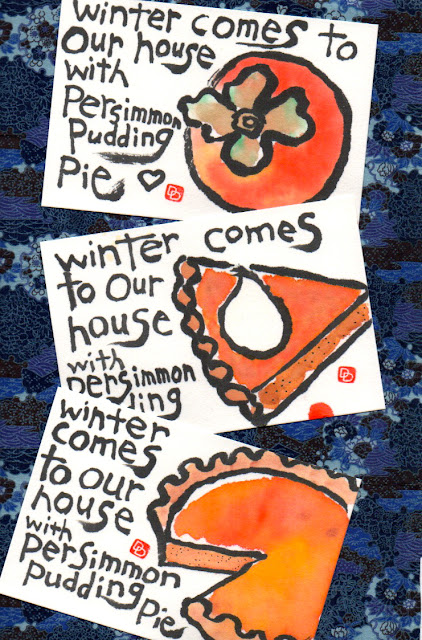Mmmm. Just love these autumn colors and flavors. (top left) Japanese sweet potatoes (satsuma-imo); (top right) crane's neck squash (tsurukubi kabocha); (bottom center) Japanese pumpkin (kabocha).
Saturday, October 29, 2016
Thursday, October 20, 2016
persimmon pudding pie
The snow bugs were right. We had our first snowfall in the city last night. Thick, heavy, wet snow. This snow will melt before the long-term, lingering snow comes; the snow that won't melt until spring. We call the long-term snow ne-yuki, which literally means "rooted snow" (snow that has taken root).
Along with the ne-yuki, winter brings persimmons. We get a big box of them from friends in Shikoku every year. Persimmons go from unripe to over-ripe very quickly, so I've learned to incorporate them into our winter menu in many forms so as not to waste a single fruit.
Once they become too soft even to peel or slice (just before they start to rot), I grip the fruit in my hand and squeeze the flesh out of the skin into a bowl. Fresh or frozen, this pulp becomes the basis for one of my favorite winter desserts: persimmon pudding pie-- a bit of sunshine to brighten our long, dark, freezing Hokkaido winters.
Monday, October 17, 2016
snow bugs
"When the snow bugs start to swarm, the first snowfall of the year will follow in a week to ten days." I was taught this in my snow-country childhood, and though I don't know the science behind it, I've never had reason to doubt it.
Snow bugs (yuki mushi) are very tiny, and when they swarm, their woolly white butts make them look like snow. They are not so easy to notice in the bright light of day....that is, until you catch them in your mouth, nostrils, and eyes while zooming happily down a hill on your bicycle into an unexpected swarm.
Apparently they belong to the aphid family, but let's not give that too much thought. Do you have snow bugs where you live?
Monday, October 3, 2016
how to make a towel brush
You will need: a disposable wooden chopstick, an old terry cloth towel, two or more ordinary rubber bands (or one large, thick rubber band as shown), water.
Cut a square piece (about 8 cm x 8 cm) out of the towel. Moisten it with water. Fold it into a triangle. Place the narrower end of the chopstick on the middle of the long edge of the folded triangle. Fold the left edge of the triangle diagonally over the stick.
Press down on the covered stick, rolling it tightly towards the right edge to make a firm, pointed tip at the end. Wrap tightly with the rubber band(s) to keep the towel in place.
Dip the towel brush into your bottle of sumi ink and draw the contour of your chosen image. To apply color, use a different (clean) towel brush, or a regular etegami brush. I used a regular brush for color.
After some practice, you may find a better way to make your own towel brush. If so, please share your ideas with me. I seem to have gone as far as I can with this method. The coarseness of the lines is intriguing, and I hope to come back to it after a good long break.
Subscribe to:
Posts (Atom)






































